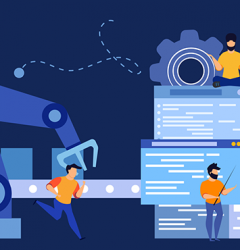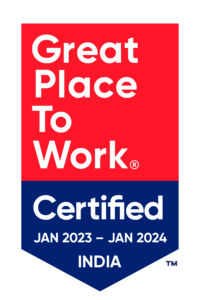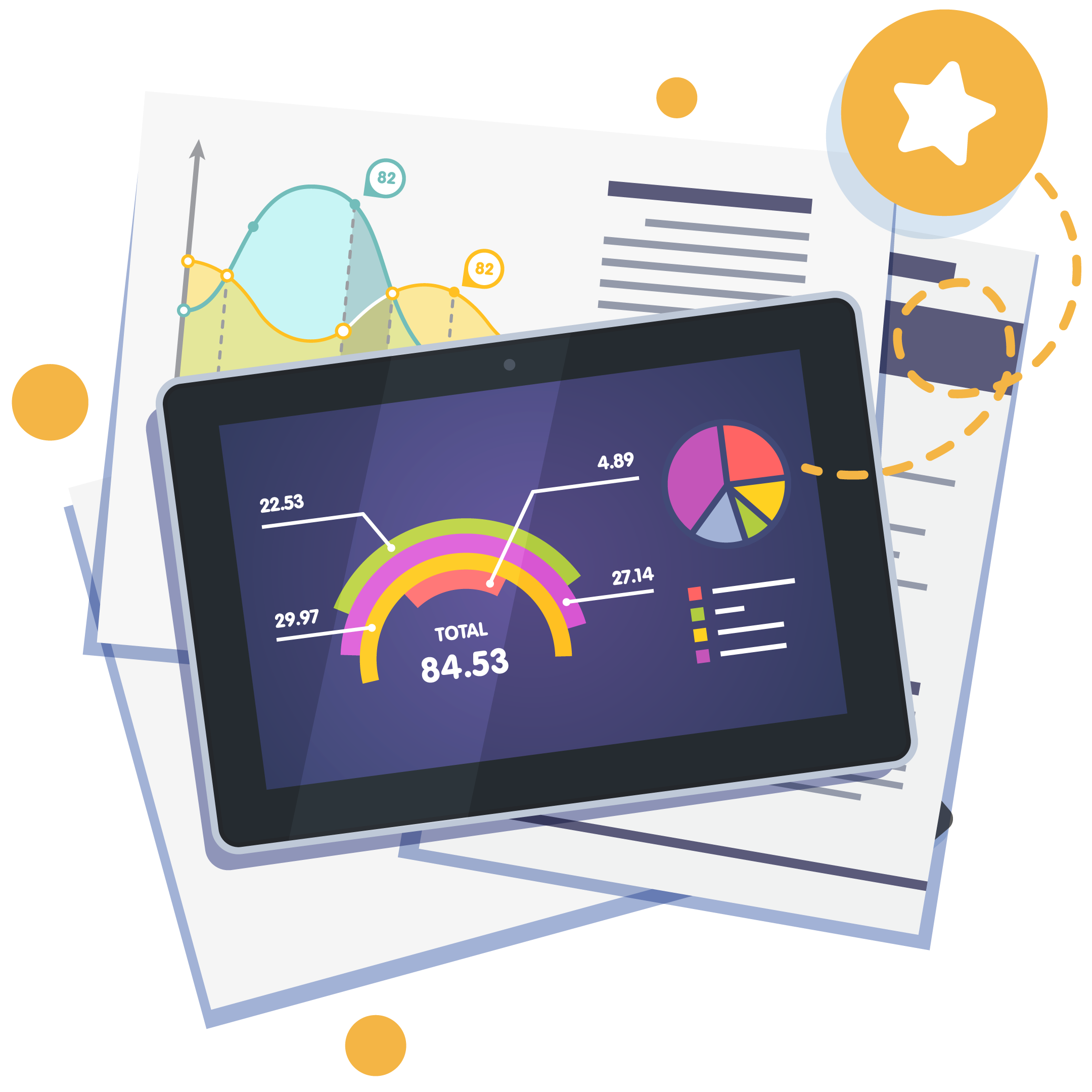02 Nov

In the dynamic landscape of business operations, efficiency is the key to success. Regardless of size or industry, every organization strives to optimize its processes and resources. One powerful tool that aids in achieving this optimization is workflow analysis. In this blog, we will delve into the depths of workflow analysis, exploring its definition, significance, and how it can transform your organization’s operations.
What is Workflow Analysis?
Workflow analysis is the systematic process of scrutinizing an organization’s workflow to enhance operational efficiency. It serves as a magnifying glass, allowing you to examine the intricate details of your business processes, identify bottlenecks, and pinpoint areas where improvements can be made.
At its core, workflow analysis seeks to streamline how tasks and activities are carried out within an organization. This encompasses everything from identifying redundant tasks to evaluating workplace layouts to ensure they are conducive to productivity.
Why Should You Perform Workflow Analysis?
Performing workflow analysis is crucial because it helps improve the efficiency of your core operational processes. Your employees spend a significant portion of their day handling tasks such as onboarding new hires, managing purchase requisitions and orders, addressing HR inquiries, processing vacation requests, and reconciling expense reports.
Through workflow analysis, you can assess these processes in detail. This evaluation enables you to pinpoint areas where tasks may become slow or inefficient, allowing for more precise adjustments to enhance overall workflow efficiency. Moreover, a well-executed workflow analysis doesn’t just identify issues; it also delves into the underlying causes that are impeding your workflows from running smoothly.
Also Read: Complete Guide to Workflow Automation Software
Benefits of Workflow Analysis in Business Processes
The significance of workflow analysis cannot be overstated when it comes to business processes. It serves as the compass that guides an organization toward greater efficiency. By identifying inefficiencies and redundancies, businesses can make informed decisions and implement changes that enhance their overall workflow.
Workflow analysis offers several significant benefits to organizations looking to improve their operational efficiency and effectiveness. Here are the key advantages:
1. Increased Efficiency and Productivity
Workflow analysis helps organizations identify inefficiencies and bottlenecks within their processes. By optimizing these workflows, companies can streamline operations, reduce redundant tasks, and enhance productivity. This often results in cost savings and a faster turnaround on tasks and projects.
2. Streamlined Communication and Collaboration
Effective workflow analysis highlights communication gaps and collaboration challenges. By addressing these issues, organizations can improve the flow of information between teams and departments. This ensures that everyone has access to the necessary data and can work together seamlessly, leading to faster decision-making and project completion.
3. Enhanced Quality Control
Workflow analysis often involves scrutinizing the steps in a process. This can help organizations implement more robust quality control measures. By identifying and addressing potential sources of errors or defects, organizations can deliver higher-quality products or services to their customers.
4. Better Resource Allocation
Understanding how work is distributed and processed within workflows allows organizations to allocate resources more effectively. This includes assigning tasks to the right individuals or teams, ensuring that resources are used efficiently, and optimizing workloads to prevent overburdening employees.
5. Adaptation to Change
Workflow analysis is not a one-time event; it should be an ongoing practice. This means that organizations are better equipped to adapt to changes in their industry or business environment. They can quickly identify and respond to shifts in customer demands, market conditions, or regulatory requirements.
Also Read: What is Workflow? Exploring the Fundamentals
6. Employee Satisfaction
Employees benefit from streamlined workflows that make their jobs easier and more efficient. When employees can complete their tasks more effectively, they often experience higher job satisfaction, which can lead to better retention rates and a more positive workplace culture.
7. Customer Satisfaction
Workflow analysis can lead to improved customer experiences. When processes are optimized, customers benefit from faster response times, fewer errors, and a more seamless interaction with the organization. This can boost customer loyalty and increase retention rates.
5 Steps in Workflow Analysis
Workflow analysis is a structured approach to assessing and improving an organization’s processes. It involves a systematic evaluation of how tasks are performed, information flows, and communication occurs within the organization. Here are the five essential steps in workflow analysis:
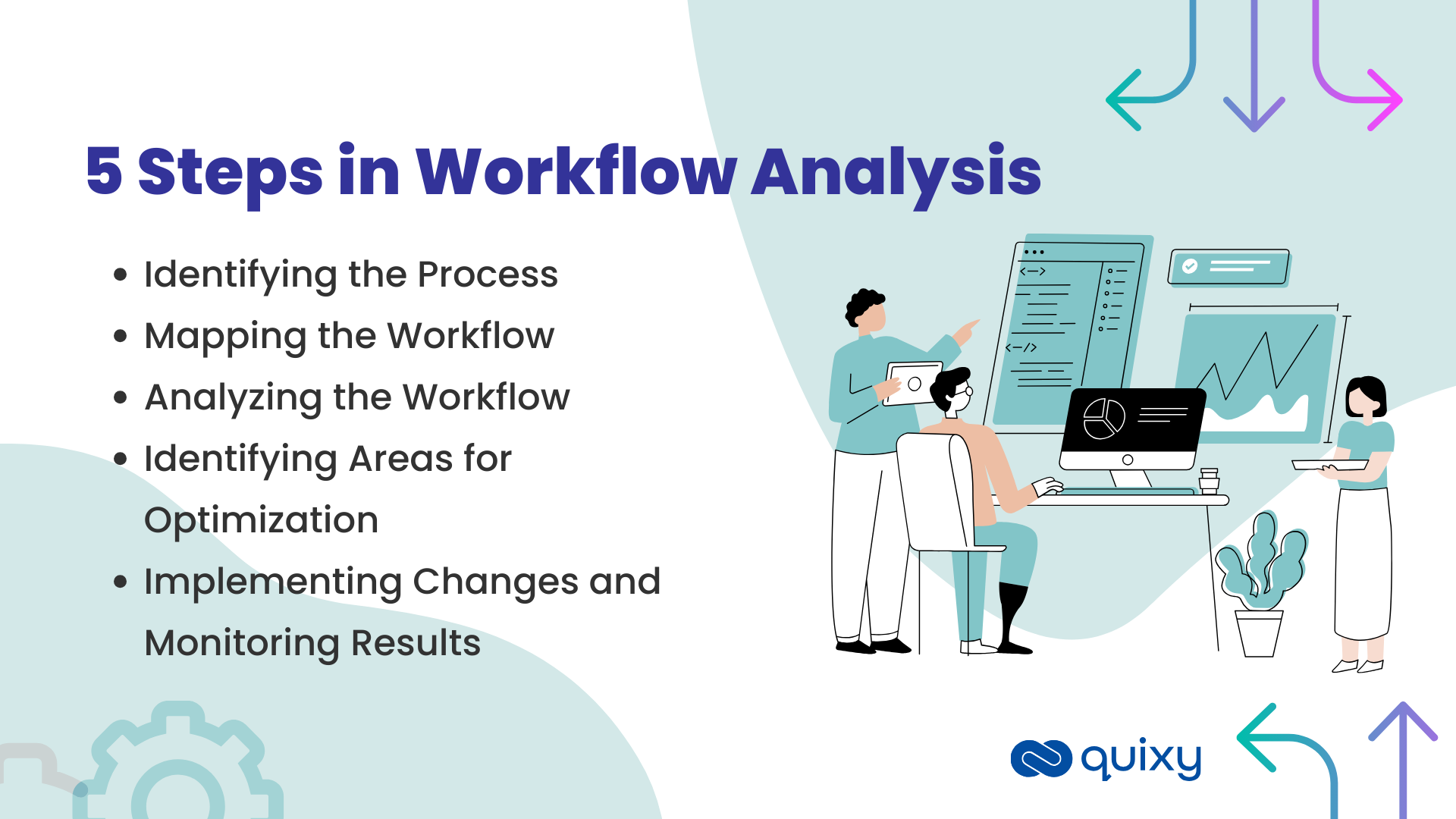
1. Identifying the Process
The first step in workflow analysis is to clearly identify the specific process or workflow that you intend to analyze. This involves understanding the objectives, inputs, outputs, and stakeholders involved in the process. You need a comprehensive understanding & mapping of what the process entails before proceeding.
2. Mapping the Workflow
Once you’ve identified the process, create a visual map or diagram of the workflow. This step involves documenting each step, task, or action. Use flowcharts, diagrams, or specialized software to illustrate the flow of activities from start to finish. Workflow mapping provides a clear and visual representation of how work progresses.
3. Analyzing the Workflow
With the workflow mapped out, it’s time to analyze it in detail. This involves a critical examination of each step to identify bottlenecks, inefficiencies, and potential areas for improvement. Consider factors such as the time required for each task, dependencies between tasks, and the overall flow of work.
4. Identifying Areas for Optimization
Based on your analysis, pinpoint specific areas within the workflow that can be optimized. Look for opportunities to streamline processes, reduce redundancy, and enhance productivity. This step may involve simplifying or automating certain tasks, reordering steps, or reassigning responsibilities to improve the overall efficiency of the workflow.
5. Implementing Changes and Monitoring Results
Once you’ve identified areas for optimization, take action to implement the necessary changes. Collaborate with relevant teams and stakeholders to ensure a smooth transition. After the changes are in place, closely monitor the results. Track key performance indicators (KPIs) to assess the impact of the optimizations. Continuously gather feedback and make further adjustments as needed to maintain and enhance the workflow’s efficiency.
Workflow analysis is an iterative process, and it’s essential to revisit and refine workflows regularly to adapt to changing business needs and evolving best practices.
Also Read: What are Workflow Diagrams? Definition, Types & Theories
Different Types of Workflow Analysis
Workflow analysis is a versatile tool for organizations seeking to enhance their operational efficiency. Here, we’ll explore the three primary types of workflow analysis:
1. Linear
Best for: Organizations with clear task steps, structured processes, and well-defined employee responsibilities.
Linear workflow analysis is like following a well-marked path. It’s ideal for companies where processes move in a linear fashion, from one step to the next. This method is straightforward, making it the most commonly used type of workflow analysis. It suits organizations with structured hierarchies and clearly defined roles.
2. Cross-Functional
Best for: Organizations with multiple departments and complex interdepartmental interactions.
In some organizations, workflows don’t neatly follow a linear path; instead, they crisscross between various departments. Cross-functional workflow analysis is tailored for such situations. It’s particularly useful when departments collaborate extensively and responsibilities aren’t clearly segregated.
3. Hybrid
Best for: Organizations with a mix of structured departmental processes and cross-functional interactions.
Hybrid workflow analysis offers the best of both worlds. It’s a blend of linear and cross-functional analysis, making it adaptable to diverse scenarios. This method is valuable when different departments work together on projects and there’s a need to optimize both individual and cross-departmental processes.
Choosing the right type of workflow analysis depends on your organization’s structure and workflow complexity.
Also Read:
Tools and Techniques for Workflow Analysis
Workflow analysis relies on various tools and techniques to streamline processes and enhance efficiency. Here are some essential tools and techniques commonly employed in workflow analysis:
1. Flowcharting
Best For: Visualizing the sequence of tasks and decisions within a workflow.
Flowcharts are simple visual representations of a workflow’s tasks and decision points. Standardized symbols are used to depict different tasks, decisions, and flow directions. Flowcharts are instrumental in helping stakeholders comprehend process structures and pinpoint bottlenecks or areas that require improvement.
2. Process Mapping Software
Best For: Visualizing and documenting workflow processes.
Process mapping software plays a pivotal role in workflow analysis. It allows you to create visual representations of your processes, making it easier to identify bottlenecks, redundancies, and areas for improvement. These tools enable teams to collaborate in real time, ensuring that everyone has a clear understanding of the workflow.
3. Swimlane Diagrams
Best For: Clarifying responsibilities and identifying handoffs.
Swimlane diagrams organize tasks and activities into distinct “lanes” based on responsible functions, departments, or roles. This approach clarifies responsibilities, reveals handoffs or dependencies between groups, and uncovers potential communication or coordination challenges.
4. Process Mining
Best For: Data-driven workflow analysis using event logs.
Process mining leverages data-driven insights by utilizing event logs generated by various systems, such as ERP, CRM, or BPM platforms. This method discovers, analyzes, and improves business processes by uncovering hidden patterns, identifying bottlenecks, and optimizing overall process performance.
Also Read: Importance of Workflow Mapping: Way to Higher Business Efficiency
5. Time and Motion Studies
Best For: Observing and measuring task durations.
Time and motion studies involve observing and measuring the time required to complete tasks within a workflow. This method identifies inefficiencies and suggests improvements, particularly in manual or labor-intensive processes.

6. Work Sampling
Best For: Estimating time allocation to various tasks.
Work sampling is a statistical technique used to estimate the proportion of time dedicated to different tasks or activities within a workflow. By collecting random samples of work over a period, analysts can identify patterns, inefficiencies, and opportunities for enhancement.
7. Stakeholder Interviews and Feedback
Best For: Gathering insights from individuals involved in the workflow.
Engaging with stakeholders through interviews and feedback sessions is a qualitative technique that complements quantitative data analysis. By speaking directly to those who work within the workflow, you can gain valuable insights into pain points, challenges, and suggestions for improvement. This firsthand input is crucial for understanding the human element of processes.
The selection of tools and techniques should align with the specific objectives and complexities of the workflow analysis project.
Features to Look for in a Workflow Analysis Tool
When considering a workflow analysis tool, it’s important to look for key features that align with your organization’s needs. While different tools may offer unique capabilities, there are some fundamental features to prioritize.
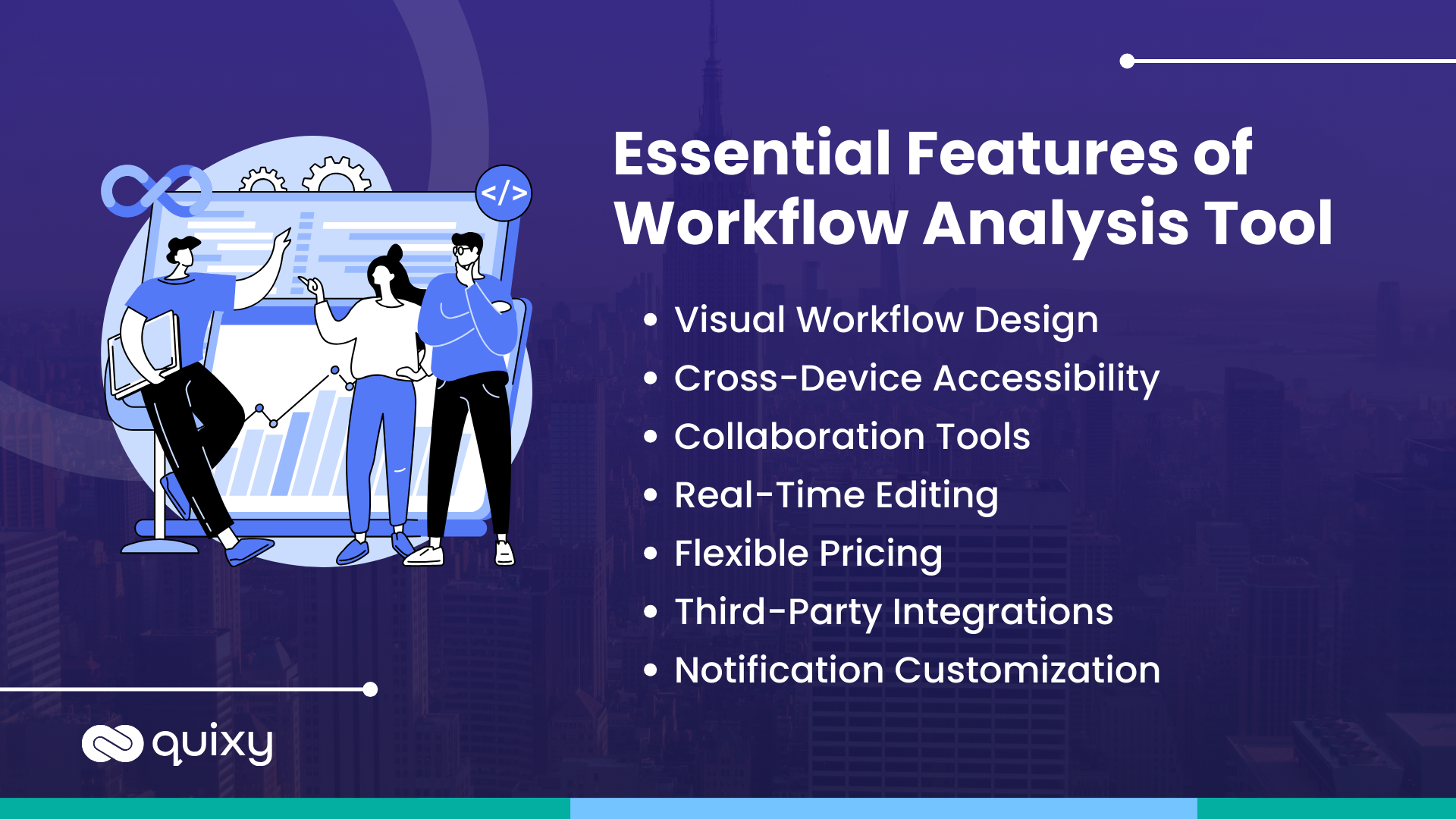
- Visual Workflow Design: A user-friendly interface for creating and visualizing workflows without requiring coding skills.
- Cross-Device Accessibility: Compatibility across all devices, including mobile, to ensure accessibility anytime, anywhere.
- Collaboration Tools: Built-in chatbots, commenting tools, and discussion boards for effective team communication and collaboration.
- Real-Time Editing: Responsive feedback mechanisms and real-time editing features to facilitate seamless workflow adjustments.
- Flexible Pricing: Scalable pricing plans that can be tailored to your specific business requirements and budget.
- Third-Party Integrations: Support for integrating with third-party applications and software to enhance functionality.
- Notification Customization: Customizable notifications, automatic reminders, and alerts to keep team members informed and on track.
- Cloud Storage: Cloud-based storage for secure and easily accessible data storage and sharing.
- Data Security: Robust data encryption measures to protect sensitive information and ensure compliance with security standards.
- Templates and Forms: Pre-built templates and customizable forms to streamline workflow creation and data collection.
- Designer Dashboard: A user-friendly dashboard with customization options for monitoring and managing workflow progress.
- PDF Generation: Automatic PDF generation capabilities for efficient report creation and documentation.
- Optimization and Analysis: Features for workflow optimization and in-depth analysis to identify areas for improvement.
Also Read: What is Process Mining? All You Need to Know
Navigating Challenges and Considerations in Workflow Analysis
Conducting a workflow analysis can be a transformative process for any organization, but it also comes with its own set of challenges and considerations. To ensure the success of the analysis and subsequent improvements, it’s essential to navigate these hurdles effectively. Here are some key challenges and considerations in workflow analysis:
1. Resistance to Change from Employees
Challenge: Resistance to change from employees can be a significant obstacle in workflow analysis. Employees may be accustomed to existing processes and hesitant to embrace new workflows.
Consideration: Mitigating resistance requires effective change management. Open communication, involving employees in the analysis process, and providing comprehensive training are essential steps to overcome this challenge.
2. Balancing Efficiency with Employee Satisfaction
Challenge: Achieving efficiency goals must be balanced with maintaining employee satisfaction. Overemphasizing efficiency can lead to burnout and dissatisfaction among the workforce.
Consideration: Prioritize the well-being of employees throughout the analysis. Encourage their feedback, implement their suggestions for improvement, and ensure that changes aim to create a positive work environment alongside productivity gains.
3. Integrating with Existing Systems and Processes
Challenge: Integrating new workflows seamlessly with existing systems and processes can be complex, especially when compatibility issues arise.
Consideration: Integration should be a focal point in workflow analysis. Ensure that proposed changes align with existing systems and consider phased implementation to minimize disruption and facilitate a smooth transition.
4. Data Privacy and Security
Challenge: Workflow analysis often involves handling sensitive data. Safeguarding data privacy and security is paramount for trust and regulatory compliance.
Consideration: Implement robust data protection measures, access controls, and encryption to secure sensitive information. Ensure that the analysis process adheres to relevant data privacy regulations.
5. Resource Allocation and Budget Constraints
Challenge: Workflow analysis demands resources, including time, skilled personnel, and potential financial investments. Organizations may face budget limitations or resource constraints.
Consideration: Strategically plan and allocate resources. Assess the long-term benefits of workflow improvements and prioritize areas with significant impact. Seek cost-effective solutions and explore collaborations with internal or external experts.
6. Documentation and Knowledge Transfer
Challenge: Documenting and transferring knowledge gained from the analysis process can be challenging.
Consideration: Develop comprehensive documentation encompassing the analysis process, findings, and implemented changes. Establish mechanisms for knowledge sharing within the organization, such as training sessions or documentation repositories.
Effectively addressing these challenges and considerations is essential for a successful workflow analysis.
Conclusion
Workflow analysis is a cornerstone for organizations, offering the means to elevate efficiency, streamline communication, and uphold quality standards. It empowers optimized resource allocation, cultivates adaptability, and enhances both employee and customer satisfaction.
Moreover, the emergence of no-code tools has ushered in a new era of workflow automation accessibility. These tools democratize the automation process, allowing individuals and organizations, regardless of their coding expertise, to harness the power of automation. No-code tools provide speed, flexibility, and seamless integrations, enabling users to swiftly develop, customize, and scale automated workflows. They foster innovation by placing automation capabilities directly into the hands of users, empowering them to experiment and optimize processes autonomously.
Organizations are encouraged to fully embrace workflow analysis, coupled with no-code automation tools, as essential strategies for success. By integrating these tools into business processes, unparalleled potential can be unlocked, leading to growth and maintaining a competitive edge in the ever-evolving business landscape.
Seize the opportunity for transformative change and secure a more efficient, effective, and innovative future for your organization!
Frequently Asked Questions(FAQs)
Q. What is a workflow & why is it important?
A workflow is the structured flow of tasks, information, and activities within an organization, ensuring efficient processes and collaboration. It is crucial for streamlining operations, enhancing employee productivity, and adapting to changing business needs.
Q. How to conduct a business workflow analysis?
To conduct a workflow analysis, follow these steps:
Evaluate the current workflow and its effectiveness.
Map the existing (as-is) workflow and identify issues.
Propose improvements for a future (to-be) workflow.
Determine the necessary tools for implementing changes.
Q. How can workflow analysis improve employee morale?
Workflow analysis can improve employee morale by simplifying tasks, reducing workload, providing clear expectations, involving employees, and fostering a better work-life balance.
Q. Why should you use a workflow chart?
A workflow chart is essential because it visually represents a workflow, making it easier to plan, communicate, standardize, and improve processes efficiently and effectively. It helps identify bottlenecks, inefficiencies, and areas for process improvement, making tasks more streamlined and consistent across the organization.
Q. What is process workflow?
A process workflow, or workflow, is a structured sequence of tasks that outlines how work is done within an organization to achieve specific goals, emphasizing task order and responsibilities. It helps standardize processes, enhance efficiency, and ensure consistency in task execution.
Q. How can workflow problems be fixed?
Workflow problems can be fixed by identifying bottlenecks, streamlining processes, automating tasks, clarifying roles, prioritizing, providing training, using technology, monitoring, seeking feedback, and documenting processes.
Subscribe
Login
Please login to comment
0 Comments


